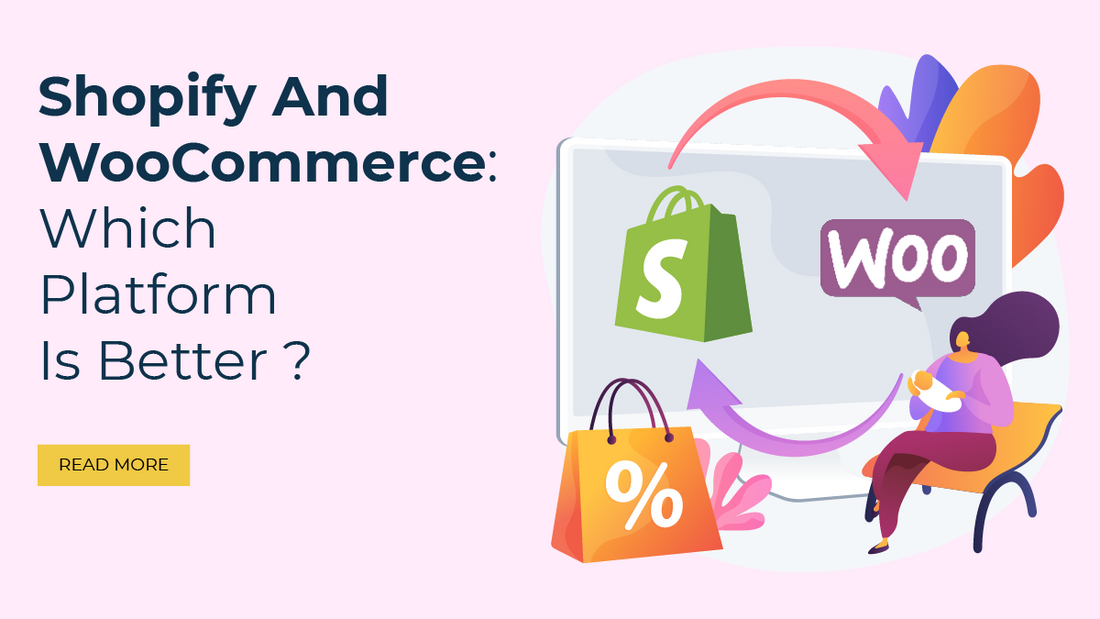
Introduction
An eCommerce platform has overtaken the marketplace and is running in full force. Almost every business has taken to the Internet and earned massive revenue. The rest of the businesses are also preparing to take off on the Internet. There is a reason behind it.
Mostly, people prefer to shop online instead of going out and selecting the particulars. It becomes very convenient for them and saves time too. That is why e-shopping websites run and earn more than physical markets.
If you want to expand your business and reach a higher level of corporate success, then you can take it online too. It’s a matter of time in the competitive world. Sustaining yourself is the biggest challenge. There are countless platforms available on the market for providing the finest layout.
Once you go through the collection available on the internet, you will discover the two most widely used and well-known platforms that can help you solve the dilemma.
Professional and outstanding applications used for setting up an online store in the modern day are Shopify and Woocommerce.
Both platforms are great.
Many times, a question pops up Which option will be the best for developing the e-commerce website?
It’s difficult to answer.
Shopify and Woocommerce are both comprehensive and unorthodox platforms. Despite this, each platform has some advantages and disadvantages. So selecting any single can be obviously a bit confusing.
The below details will make it easy for you to make the best choice.
We will help you decide which platform you prefer or which will provide a solid foundation for your online store.
We are going to differentiate between Shopify and Woocommerce. So let’s see, did it work out or not?
First, let’s gain some basic information regarding a couple of applications.
What is Shopify?
Shopify is an undivided application and platform that came into existence to create online business stores. It can easily produce a comprehensive shopping site that accepts payments and manages your inventory efficiently. It’s a completely secure platform that focuses on web hosting and caching as well.
What is WooCommerce?
WooCommerce is a WordPress plugin that you can easily integrate with open-source CMSs and run online. Many consider WooCommerce the best and most powerful platform compared to Shopify or any other, as it offers easy customization due to its open-source nature.
What factors do you need to keep in mind while selecting an eCommerce platform?
Whenever you want to start building your online store, you have to keep the following factors in mind that can make your website unified:
- Budget: The initial cost of designing and developing the fully functional eCommerce store.
- Ease of use: The system should allow for easy operation.
- Payment Methods: The platform should support multiple compensation options.
- Integrations: It must allow you to integrate services and third-party tools into your eCommerce business site.
- Scalability: The platform can maintain the scalability of your business.
These are the fundamental factors you need to concentrate on while starting to choose a platform for your shopping web development. In the end, it all depends on the needs and technical requirements of your project. Furthermore, you must look for other options like shipping, inventory management, invoicing, taxes, dropshipping, etc.
Now let us compare the two first-rate platforms, i.e., Shopify and Woocommerce, so that you can choose any one of them for your online shopping website design.
VW themes have an e-commerce WordPress theme for an easy ongoing process.
Comparison between Shopify and WooCommerce
Shopify
- Cost of Shopify
Website owners must first evaluate the cost of the tool and its implementation. If you choose Shopify to use as a platform to develop an eCommerce website, then you need to pay $39 per month for the basic plan, and you can upgrade to the next plan worth $105 per month. The advanced Shopify plan is accessible for $399 per month. You will get an SSL certificate and web hosting in every plan along with the Shopify branded subdomain (e.g. https://your-store-name.myshopify.com). You can purchase the domain name separately. Shopify has a Starter Plan that costs $7.00 per month. In this, you will buy buttons for any website.
- Easy to use
Shopify is a user-friendly and self-hosted platform that does not require any kind of extra effort to install, manage, configure, or update anything. It’s a completely independent and secure platform that gives great performance, backups, and compatibility. You can have any free Shopify theme and start to customize it as per your preferences. It allows you to add multiple products with easy customization.
The drag-and-drop service can be responsible for creating a wonderful and easy interface. Shopify also has the ability to adjust product pages, sales, and inventory inside Shopify. There is only one drawback to using Shopify: this platform restricts some things, or, you can say, controls your activities. For example, Shopify only allows you to use Shopify provides designs and development tools, along with add-ons available in their marketplace. Starting and launching your online store is most effectively accomplished through Shopify.
- Payment options in Shopify
When a customer checkouts from their account, Shopify offers multiple payment options. Also, it has its own payment system known as Shopify Payments (powered by Stripe). Along with this, Shopify supports famous third-party payment gateways as well.
Using third-party payment gateways with Shopify results in an additional 2% penalty on every transaction, whereas opting for the Advanced Shopify Plan at $399 per month reduces the transaction cost to 0.5%.
Using a credit card through Shopify Payments, you have to provide rates that start at 2.9% + 30 for the basic plan. You can get the other plans too, at lower prices.
- Add-ons and Integrations
Shopify has a dynamic API and an App Store that allow you to shop for third-party add-ons. It consists of hundreds of feature-rich apps that you can easily integrate into your online store. Shopify can integrate plugins like OptinMonster to display a lead generation form on your website. You can get the benefits of Shopify apps for search engine optimization, product reviews, discounts, countdowns, and more for free. There are some paid apps, too.
Shopify has fewer options for add-ons and extensions than WooCommerce or WordPress.
WooCommerce
- Cost of WooCommerce
WooCommerce, an open-source and free self-hosted WordPress plugin, is known for its functionality. If you wish to choose WooCommerce as a platform to launch your online store, you will need a complete package of a domain name, an SSL Certificate, and a WordPress hosting account.
WooCommerce is free, but you will incur charges of $14.99 for a domain name, $69.99 for an SSL certificate, and $7.99 per month for web hosting.
To obtain these services at lower prices, you can connect with hosting companies that offer specialized WooCommerce hosting plans, which can significantly reduce the cost.
So you must have realized that WooCommerce has lower prices than Shopify.
So it’s been clear that WooCommerce is an affordable platform that provides free themes and free add-ons.
- Easy to use?
Like Shopify, WooCommerce is not a hosted platform. It means that you will have to install the WooCommerce plugin, adjust the updates, and keep backups. Apart from this, you will have to make sure that your website is completely secure. For this, you can make use of multiple free and paid plugins available to automate these tasks. A fully-flexible and customized WooCommerce platform can control the flow of your site. It allows you to add any functionality to your website. It doesn’t have an in-built drag-and-drop design builder. In terms of management, you need to be very precise and know every angle of your website. You need to register for a business account and other payment gateway services like Stripe/PayPal. WooCommerce comes with a setup wizard that can never give you the best user experience in terms of ease.
- Payment Options in WooCommerce
By default, WooCommerce uses PayPal and Stripe payments. Stripe also supports the WooCommerce Payments solution, making the process easy. You can see all the support for all the well-known payment service providers in WooCommerce.
Surely, you can integrate with various authorities like Amazon Pay, Square, and many others.
WooCommerce is a flexible platform in terms of payment integration services. It supports all kinds of WooCommerce add-ons. In addition to this, WooCommerce doesn’t ask for any percentage on credit card payments, which is a great thing.
In short, WooCommerce can save you money and give you the best services at the best price.
- Addons- and Integrations in WooCommerce
WooCommerce's flexibility allows it to integrate with over 59,000 free WordPress plugins and numerous additional paid plugins. If you want to integrate payment portals, lead generation forms, SEO for eCommerce, optimization in performance, and social media integration, it will surely be beneficial. There are a lot of Best Woocommerce Product Add-Ons for enhancing the Woocommerce Store.
Nearly all third-party tools and service providers can add their own plugins to the WooCommerce store.
I highly recommend the best WooCommerce plugins for better integration with WooCommerce.
- OptinMonster
- All-in-One SEO
- MonsterInsights
- SeedProd
- FunnelKit
- Advanced Coupons
- Wholesale Suite
Difference between Shopify and WooCommerce
You can create a plugin for your own website by appointing a WordPress developer.
We have studied the fundamental differences between Shopify and WooCommerce. Now we will see the core difference between these two magnificent platforms, which will help you make better decisions easily.
| Sr. No. | Shopify | WooCommerce |
| Won’t provide the customizable options. | You can get countless customizable options like 1000+ plugins and more than 1000 themes. | |
| It’s an easy-to-use e-commerce solution for business websites. | It’s difficult to configure the online store. | |
| Shopify has more payment options than WooCommerce. | WooCommerce has fewer payment options in comparison with Shopify. | |
| It’s an easy-to-use e-commerce solution for business websites. | It’s a cheaper platform than Shopify. | |
| You can get multiple pricing plans on Shopify. | WooCommerce is free to use. | |
| Simple and user-friendly interface. | easy-to-use interface. | |
| Fully compatible with WordPress, so it is optimized for SEO. | Fully compatible with WordPress, and so it is optimized for SEO. | |
| Shopify's SEO options are limited by default. | As It’s a self-hosted WordPress, it is compatible with all the WP themes and templates. | |
| It’s an easy-to-use e-commerce solution for business websites. | No dedicated or direct support. |
Conclusion
Every coin has two sides. Shopify and WooCommerce are the top and leading platforms in the modern and professional area of web development. We listed all the core and pivotal differences between the two. Now, you have to choose one that resonates with your e-store requirements.

The WordPress theme bundle plays a crucial role in the ongoing debate between Shopify and WooCommerce. While both platforms serve as popular choices for e-commerce, the theme bundle becomes a pivotal factor for businesses seeking to establish their online presence. WooCommerce, integrated with WordPress, offers a wide array of customizable themes through its bundle, allowing merchants to tailor their storefronts to match their brand identity. On the other hand, Shopify has designed its themes to seamlessly align with its proprietary platform, while also maintaining versatility. The choice between the two ultimately hinges on whether a business prioritizes the extensive customization options and seamless integration of WooCommerce's theme bundle within the WordPress ecosystem, or the user-friendly and all-inclusive nature of Shopify's theme offerings tailored specifically to its platform.









